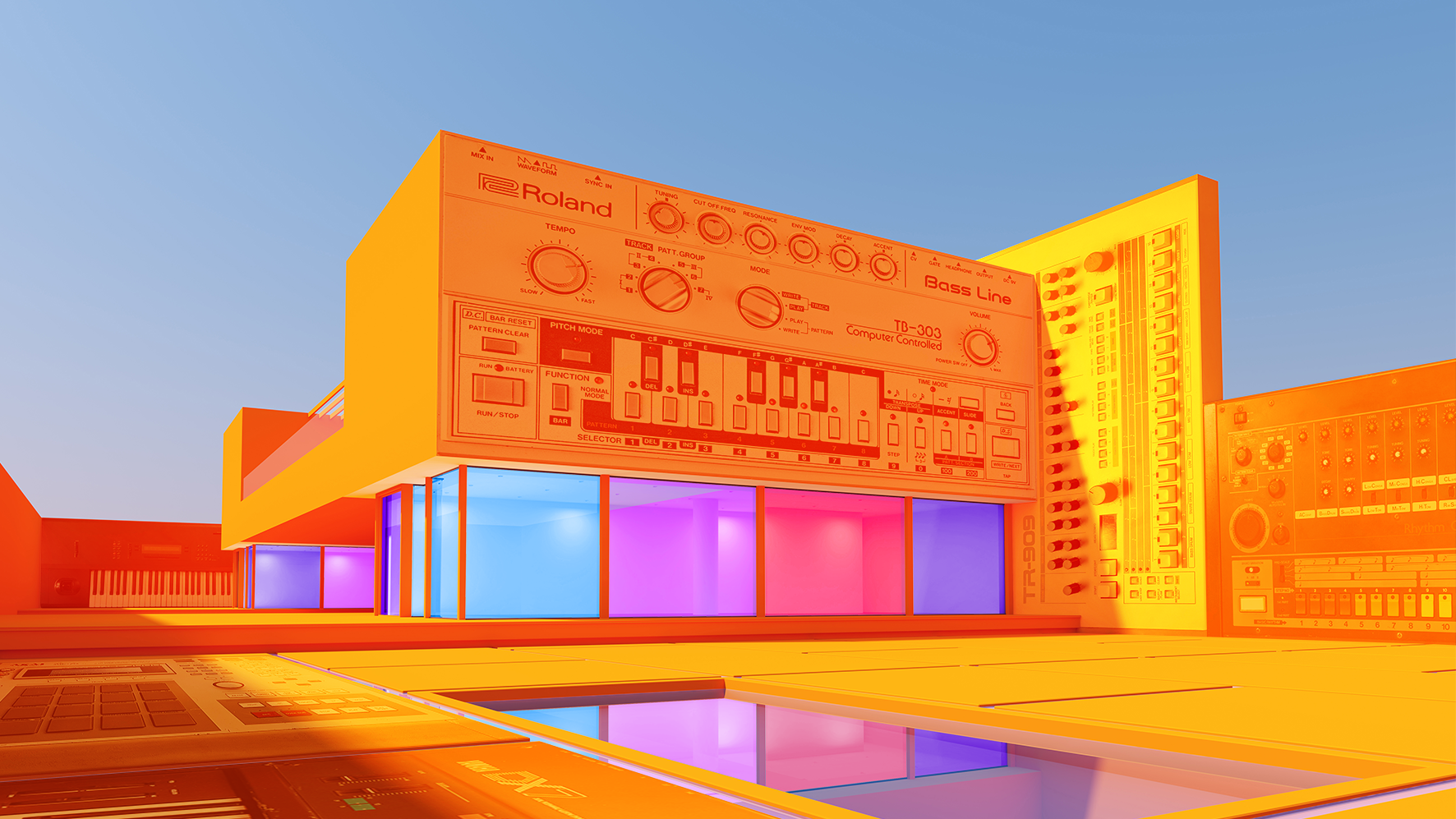
It’s not a competition, but if we were to crown one electronic genre as the one that represents dance music in its purest form, it has to be house.
House music is the genre from which countless others were born. It was the genre that gave birth to DJing and clubs as we know them, spanning from its black and queer roots in Chicago to arenas, festivals and pop charts across the world. Sure, techno has a decent claim to equal longevity and popularity, but it hasn’t reached quite so deeply into both the commercial and underground realms as house.
That spread has meant that, in 2023, it’s hard to define ‘house music’ as any one thing. It’s a genre tag that encompasses everything from Beyoncé and Kylie Minogue through to big-room Ibiza house and EDM, to fresh takes on the sound coming out of Africa and South America, the weirder, lo-fi sounds of the UK and European underground, and back to the raw house styles still coming out of Chicago and Detroit.
So our ‘definitive guide’ is doomed to be anything but. Instead, here we’ll explore a few lasting, core genre tropes, as well as the ways that modern gear lets us put a fresh spin on things.
The house toolkit
Like most electronic genres, early house music was defined as much by the instruments used to make it as its musical influences. While the genre is directly descended from the lush orchestrations of funk, soul and disco, it’s equally born out of the sampling techniques and synths and drum machines – most notably Roland’s TR boxes – used to turn the loose grooves of disco into longer and more repetitive tracks suited for the Chicago clubs where house first rose to prominence.
In 2023, it’s important not to get too hung up on this vintage gear
In 2023, it’s important not to get too hung up on this vintage gear. You don’t need a huge studio stocked with classic hardware to make a great house track. That said though, an awareness of the kit used by dance producers in the late ’80s/early ’90s can still provide a useful foundation when it comes to establishing your own sound. Analogue drum machines, hardware synths, crunchy samplers, budget mixing desks, outboard effect units and cheap guitar pedals were all available at the time. It’s possible to emulate these effects using software plugins or more affordable, modern equivalents.
You’ll get close by sourcing the original drum sounds from classic machines such as Roland’s TR-808 and TR-909 – you’ll find some in our sample archive – so load up some one-shots into your drum software of choice. A pad-based soft sampler and MIDI controller combo (think Push, Maschine or similar) will go a long way in replicating the workflow and vibe of a retro MPC setup.
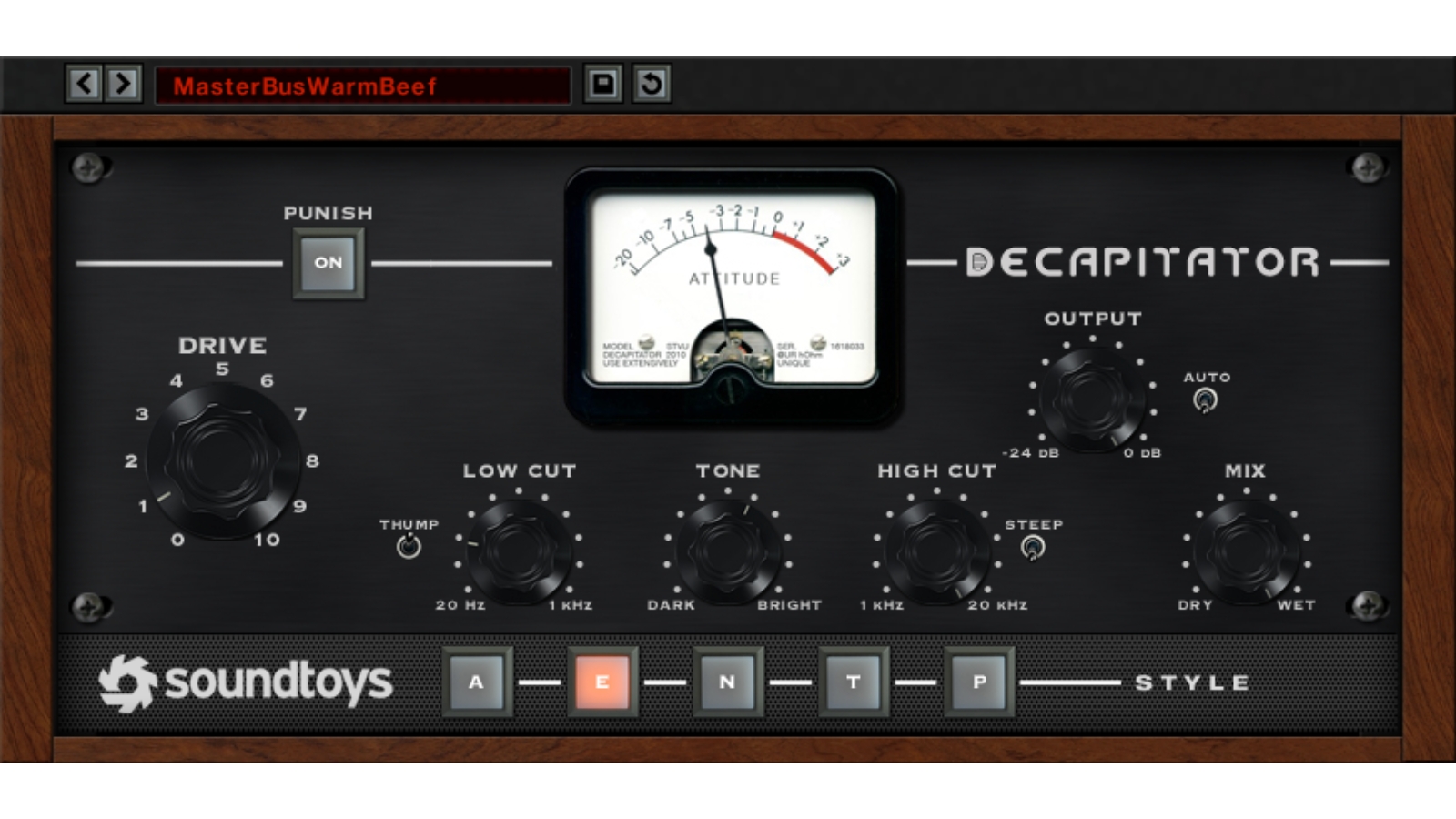
Best saturation plugins 2023: Bring your mix to life with these studio secret weapons
These drum machine hits can be a little thin, so a high-quality saturation effect can impart that driven character that was once achieved with pedals and sampler overdrive. Saturn 2 by FabFilter, Output Thermal and u-he’s Satin all offer great quality drive and distortion in the box. For the crunchy 12-bit lo-fi effect of early hardware samplers, get busy with a bitcrusher on drum parts. Analogue-style EQ can also tame harsh treble and add ‘warmth’ to sterile samples.
Affordable mixers would sum signals in a characterful way, and their preamps were overdriven for extra fuzz, an effect that can be replicated to some degree using one of the many console emulation plugin collections available.
For those looking to replicate the feel of classic house records, replicating the production ethos can be just as, if not more, important than replicating the sound of the gear itself. Many early house records were made using cheap, limited setups, often used creatively to get the most out of their capabilities.
Take a more back-to-basics approach to sampling, eschewing automatic warping and pitch-shifting functions in favour of manually repitching loops by ear
House producers couldn’t afford to record the string arrangements of disco and soul records, so layered synths and samples were used instead. Samples were taken from vinyl records, using gear with limited sample times and sync capabilities, resulting in looser, less clean samples that were characterful as a result.
A similar approach can be achieved by pushing cheap and readily available hardware to its limits – try creating full tracks with a couple of Korg Volcas and some cheap guitar pedals, for example. Another good move is to take a more back-to-basics approach to sampling, eschewing automatic warping and pitch-shifting functions in favour of manually repitching loops by ear and slicing elements by hand on a timeline.
Beyond the 808 and 909
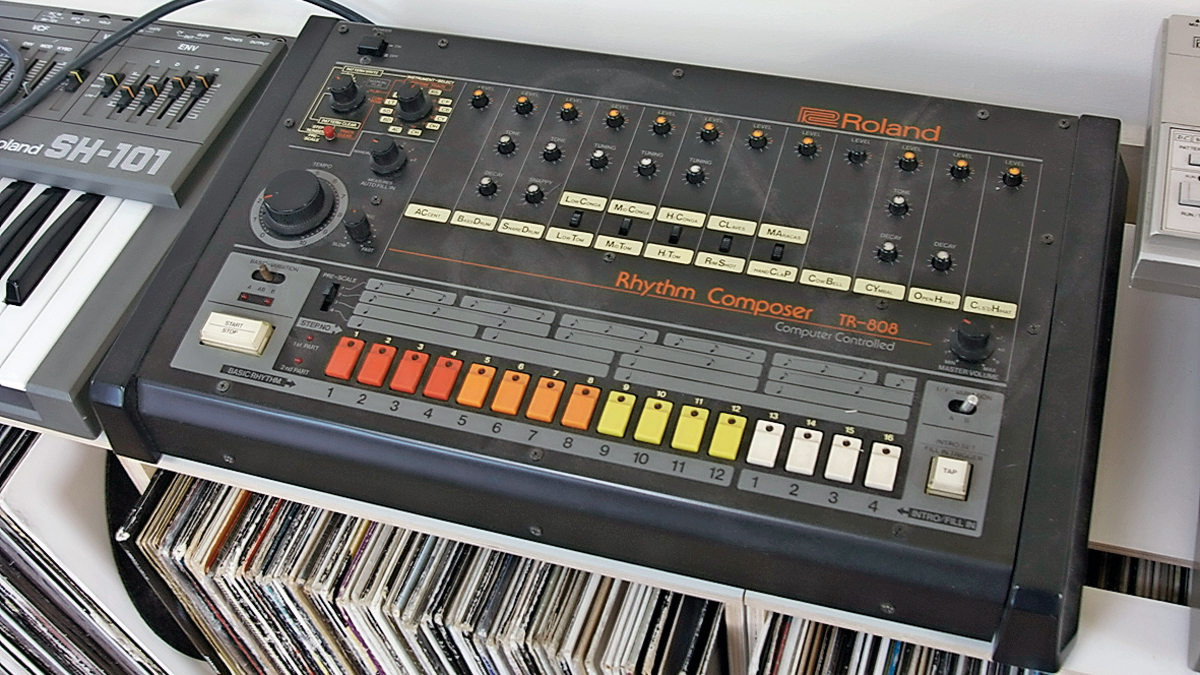
Roland’s TR drum machines, specifically the 808, 909 and – to a slightly lesser extent – the 707, are still very much the core of the house sound in 2023. Skim through the top house releases on any streaming service and it will become immediately apparent just how prolific the crunchy claps and tight hi-hats of those early grooveboxes and their modern sound-alikes remain.
Still, even the most traditionalist house producer is unlikely to stick to just these classic drum sounds without deviation. For all of their influence and longevity, those classic drum machines are rather limited, and limiting yourself to only using a few vintage sounds is a surefire route to boring and samey productions.

One of the most common tricks in house music production is to add a ‘looser’ feel to drum patterns with the addition of organic-sounding or acoustic percussion. Shakers, tambourines, bongos, congas or any kind of hand-played percussion is great for this. It’s best to work with loops rather than one-shot samples here, as the aim is to capture the feel of the playing as much as the sound of the instrument, which can easily get lost when sequenced using a DAW.
There’s no end of samples available online - we've got nearly 90,000 free music samples for you right here. For something more unique though, take a DIY approach. Record loops of whatever you have to hand, whether that’s basic percussive instruments, or even just shaking your keys or tapping your desk. It’s amazing how something so basic can help bring a synthesised groove to life.
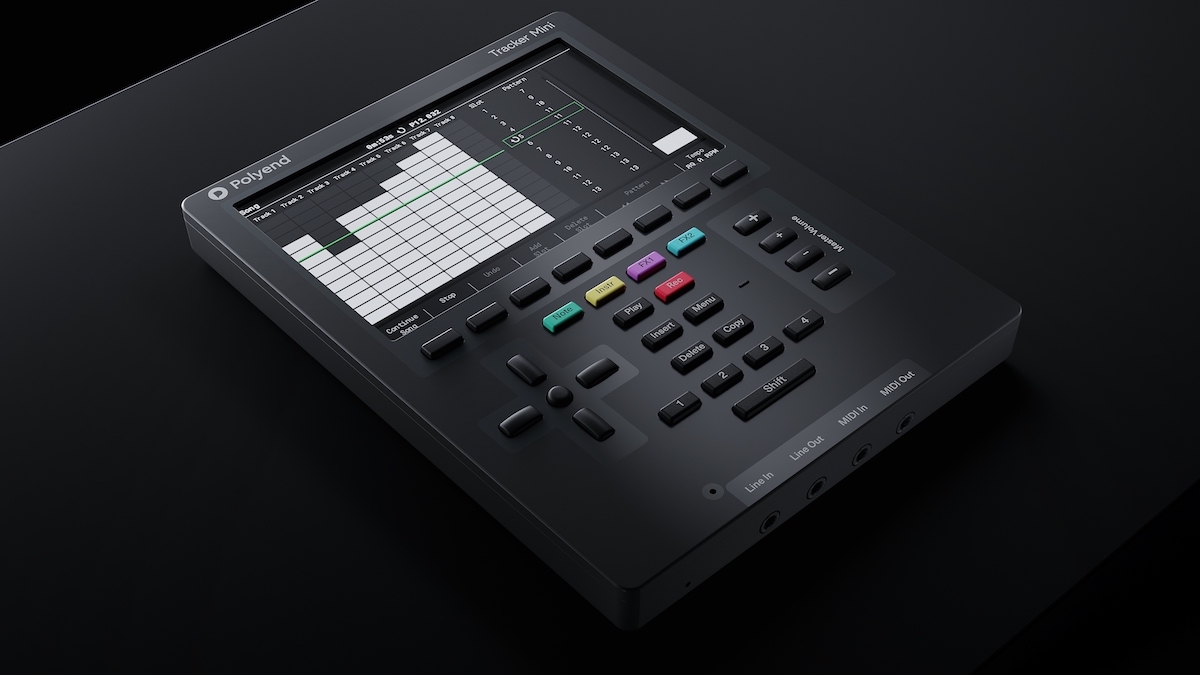
Another resurgent technique, with its roots in ’90s raves, is to blend sampled drum breaks in with sequenced drum machine rhythms. This is far easier to do in 2023 than it would have been in the ’90s: simply load your break of choice into your DAW and slice its transients to a MIDI instrument.
For authenticity though, try applying some bit-crushing for a ‘crunchy’ sound, or turn to a hardware sampler like Korg’s Volca Sample or Elektron Digitakt. Trackers provide a great, old-school way to approach break sequencing too. Polyend’s modernised Tracker and Tracker Mini are particularly great tools for detailed, ’90s-style editing.
House hooks
What is it that differentiates house from other electronic genres? There are multiple common answers to this, none of which are exactly definitive. Its BPM – usually between 115 and 130 – is an obvious signifier, but this crosses over with a lot of techno and electro too.
Compared to those genres, there are notable differences in the sound and feel of the rhythm. While each has roots with Roland’s ’80s drum machines, house tends to incorporate more organic elements like acoustic percussion and ‘live’ shaker or tambourine rhythms. Grooves tend to be looser too, with more swing than machine-like techno.
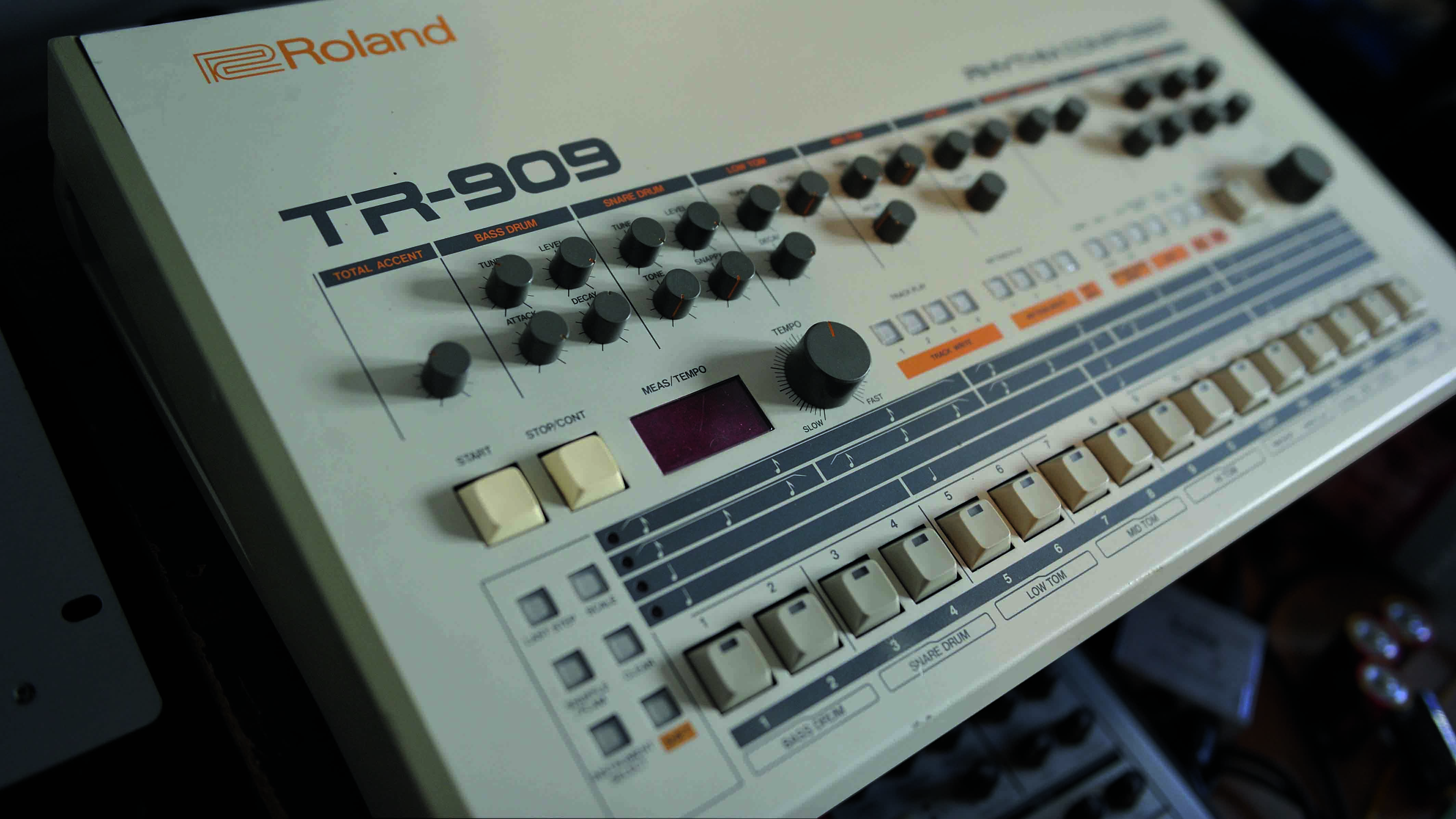
Probably the most consistent point of difference between house and techno is the fact that the former puts far more emphasis on traditional song structures and ‘hooks’. A techno track can often work with little more than a rolling drum rhythm and repetitive bassline, perhaps with sparse use of samples and effects to keep things interesting.
Probably the most consistent point of difference between house and techno is the fact that the former puts far more emphasis on traditional song structures and ‘hooks’
With its roots in disco and funk, however, house has always kept one foot in the world of traditional ‘songs’ even as it moved onto the dancefloor. While not every house track will have verses and choruses – although a fair amount of them do – it is common for tracks to be structured around identifiable elements like vocal hooks or chord progressions.
Taken together, this gives us a rough idea of house’s common characteristics, if not a hard-and-fast definition. That lack of specific rules is something to be embraced though; part of the genre’s longevity lies in its shifting nature. Over the decades house has morphed into sub-genres and cross-pollinated with other styles of electronic music, simultaneously crossing over into the mainstream and venturing into the underground as it’s done so.
3 approaches to sampled house vocals
With its roots in disco, funk and soul, house has always been a vocal-heavy genre. Many classic – and modern classic – tracks use featured vocalists to provide the track’s hook. This is great, but requires access to a great singer, and recording capacity to match.
This hurdle is why, pretty much since the genre’s invention, house producers have been using sampled vocals which they can repurpose to provide hooks. The traditional place to source vocal samples would be from vinyl records; generally producers would rely on finding vocal breaks with few or no instruments in the background.
These days, there’s a wealth of purpose-built samples available from the likes of Splice or Loopcloud, while YouTube can also provide a deep well of esoteric sample sources. But how to use these? Here are three tried and true approaches…
1. Repurposed acapellas: DJ Koze - Pick Up
Many of the best house vocal flips don’t overthink things. DJ Koze’s Pick Up is a great example. Its hook is a fairly straight lift from Gladys Knight’s Neither One Of Us. Comparing the track to the original, there’s not a lot that’s been done beyond some minor editing to make the hook fit Koze’s rhythm track. The skill in this case simply comes from being able to identify a winning hook.
2. Vocal chops: Nightcrawlers - Push The Feeling On (MK Dub Remix)
Pioneered by the likes of MK and Todd Edwards, the chopped vocal involves slicing a sample into parts and resequencing them, overtly editing rhythm and pitch in the process. This is easy now that most DAWs have ‘slice to MIDI/sampler’ functionality. Once sliced, try playing your vocal with a MIDI controller/keyboard for a more rhythmic effect.
3. Spoken word: Cajmere - Percolator
While a beautifully sung melodic hook is great, simple, distinctive spoken word hooks can be as impactful. Percolator is the obvious example here, but the whole career of Green Velvet (aka Cajmere) is a good reference. One of the best things about these types of vocals is they can be recorded in a DIY manner and allow for experimenting with effects or even vocoding.
Arrange a house track in 6 steps

1. A and B sections
House as a genre is a little more ‘song’-focused than loop-focused techno or DnB, which puts a lot of emphasis on builds and drops. While your track doesn’t necessarily need full verses and choruses, before tackling an arrangement for your house track it’s worth developing at least two distinct sections, labelled A and B.
These should be variations on one another, giving you two versions of your main hook to switch between to keep the listener interested. If the main emphasis is a sampled vocal, try using two different looped lines or phrases to make different sections. If your track is built around a distinctive riff or progression, try swapping the instrument in the second section or inverting its direction so the notes progress down the scale rather than up (or vice versa).
2. Subtracting
Any arrangement tutorial will mention the ‘subtractive’ method of turning an eight- or 16-bar loop into a full track. To recap, you simply lay all of your elements out across your arrange page for the requisite number of minutes – in this case your full A and B sections – then delete parts until you’re left with a typical dance track structure. The idea is that it’s far easier to chip away from something instead of staring at a blank canvas, which is certainly true.
It’s a tantalisingly simple approach, but while it does work, you still have to ‘patch up’ transitions to fill in gaps between sections, otherwise you can be left with a somewhat generic, eJay-style ‘block-based’ arrangement. What this approach also misses is that sometimes there’s a lot of mileage in keeping your arrangement interesting by swapping like-for-like elements, rather than simply removing them. For example, switching an open hi-hat for a ride cymbal playing the same pattern, or trading piano chords for a synth pad.
3. Basic structure
What should your house arrangement look like? There are no hard and fast rules, and you should defer to what feels right, rather than try to force your ideas to fit a specific template. That said, the following format makes a good starting point:
Intro section > build-up > first breakdown > main A/B sections > second breakdown > main A/B sections > outro
Let’s look at this piece-by-piece. The intro (discussed below) is a stripped-back section making it easy for DJs to mix into your track. The build-up is an evolution of this, introducing elements such as percussion and bass, without revealing the full impact of the track.
The first breakdown is generally shorter than the second. It’s a moment to pull things back to create extra impact when your main ‘A’ section is introduced. You might choose to cut the kick and/or bass here, and insert an element that leads into your main section, like a distinctive vocal hook or chord stab.
The main A/B sections are the core body of your track: its hook and groove, the elements capable of the most dancefloor impact.
The second breakdown is likely longer than the first and should be different, to avoid repetition. Try using filters and effects here to ‘wash out’ your groove before bringing everything back in for full impact.
For the repeat of your main A/B section – ie the second ‘drop’ or hook – try introducing a subtle change such as a synth pad or new percussive element.
Finally, the outro gradually strips elements away, giving DJs a sparse section that can easily be mixed into the next track.
4. Intros and outros
As music primarily designed for clubs, it’s common for house tracks to include extended intro and outro sections making it easy for DJs to mix out of/into other tracks. Don’t get too bogged down on creating these early on; it’s generally something that’s easy to develop once the main body of your track is in place.
The general rule for these mix sections is to include the basic percussive elements of your track without anything too melodic that might clash with another track in the mix, such as chords, complex basslines or vocal hooks. However, just because something is supposed to be simple, doesn’t mean it needs to be boring.
Try to include some kind of simple but distinctive element to make your intro stand out, such as unique rhythmic FX or a sparse vocal hit. These kinds of distinctive elements can make your track more appealing to DJs, giving them something they can tease the crowd with as they mix the track in.
5. Use dynamics
It’s tempting to pile up more and more sounds in the search for change and interest. Counterintuitively, though, it’s often the quiet moments between the intense sections that give a track real power and flow – you can’t really have moments of high intensity without contrasting sections of low intensity.
Subtle dynamic interplay is what separates the classic house sound from more in-your-face EDM. While the latter genre’s more ‘big room’ approach tends to emphasise bigger and bigger drops and in-your-face transitions, the more groove-focused house approach works by making small changes, like cutting a clap for four bars, switching one percussive sound for another, or cutting back sounds using filter or envelope changes. Try rolling down filter cutoff on some of your main elements to make a ‘quiet’ section, before reintroducing sounds at full force.
6. Reference
The use of reference tracks when mixing is common… but have you tried using reference material to guide your arrangement?
Find a track you like, place it from left to right on your timeline, then use your DAW’s marker feature to plot important sections – eg, intro, breakdown, etc. Then delete that track from your timeline and use the markers to guide your arrangement.
Another great reference method is to load it into your favourite DJ software/player and try mixing it with tracks you like. How do the dynamic changes, hooks and transitions sound in a mix? How do the various frequency elements of your track match up to a commercial release? How easy is it to mix in and out of your track? Let these factors influence changes to your final track.
Creating a classic house beat
This classic house beat is built using TR-909 drum samples: click here to download the samples we're using and hear the full pattern.
The kick is punchy, but doesn’t feature a long tail, leaving space for a weighty bassline to work around it. Velocity variations are programmed in and an MPC swing template is applied for that ’90s garage-esque shuffling groove – moving every second and fourth 16th-note back a touch.
Things would sound much more rigid and robotic without this effect, so be wary of keeping all your own parts locked to the grid if this is the effect you want.
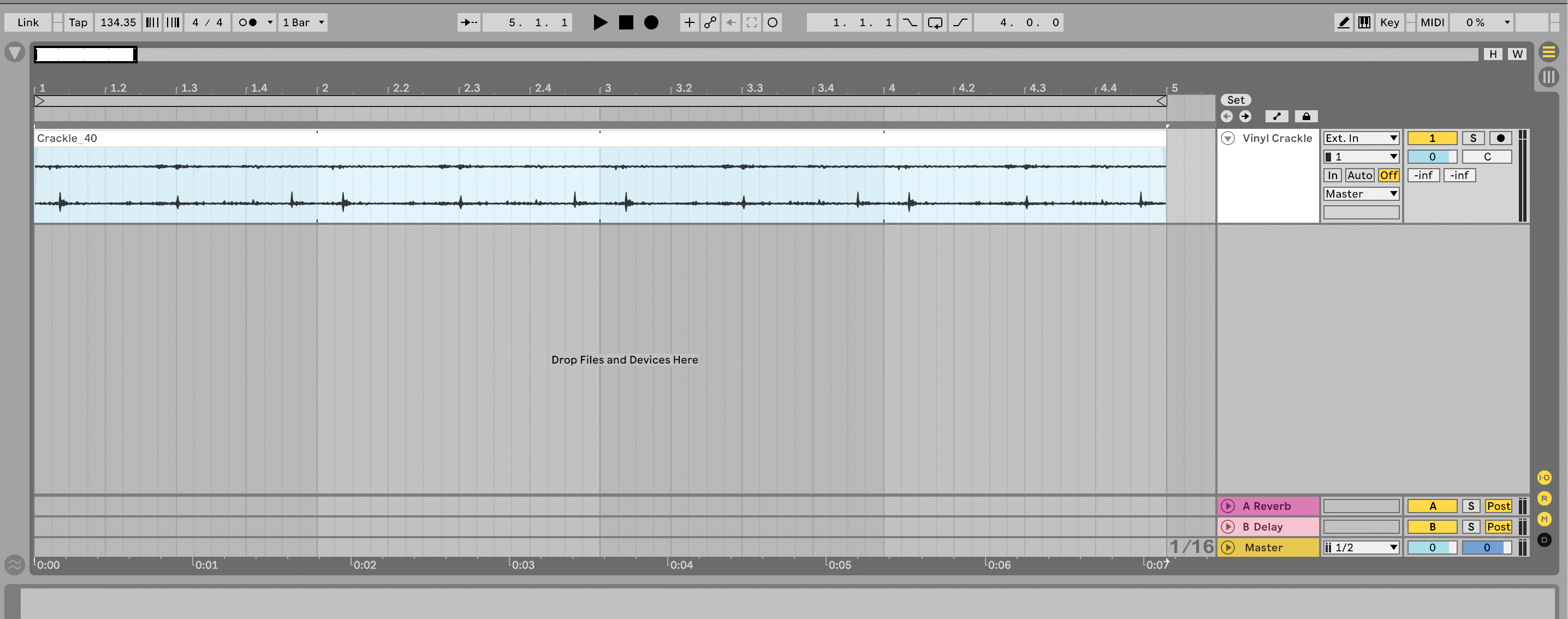
To lay down an initial foundation for our drum groove, we loop up a sample of some crusty vinyl crackle to create the illusion that our track is sampled from a record. Some subtle sidechain-esque volume pumping gives this noise some rhythmic movement.
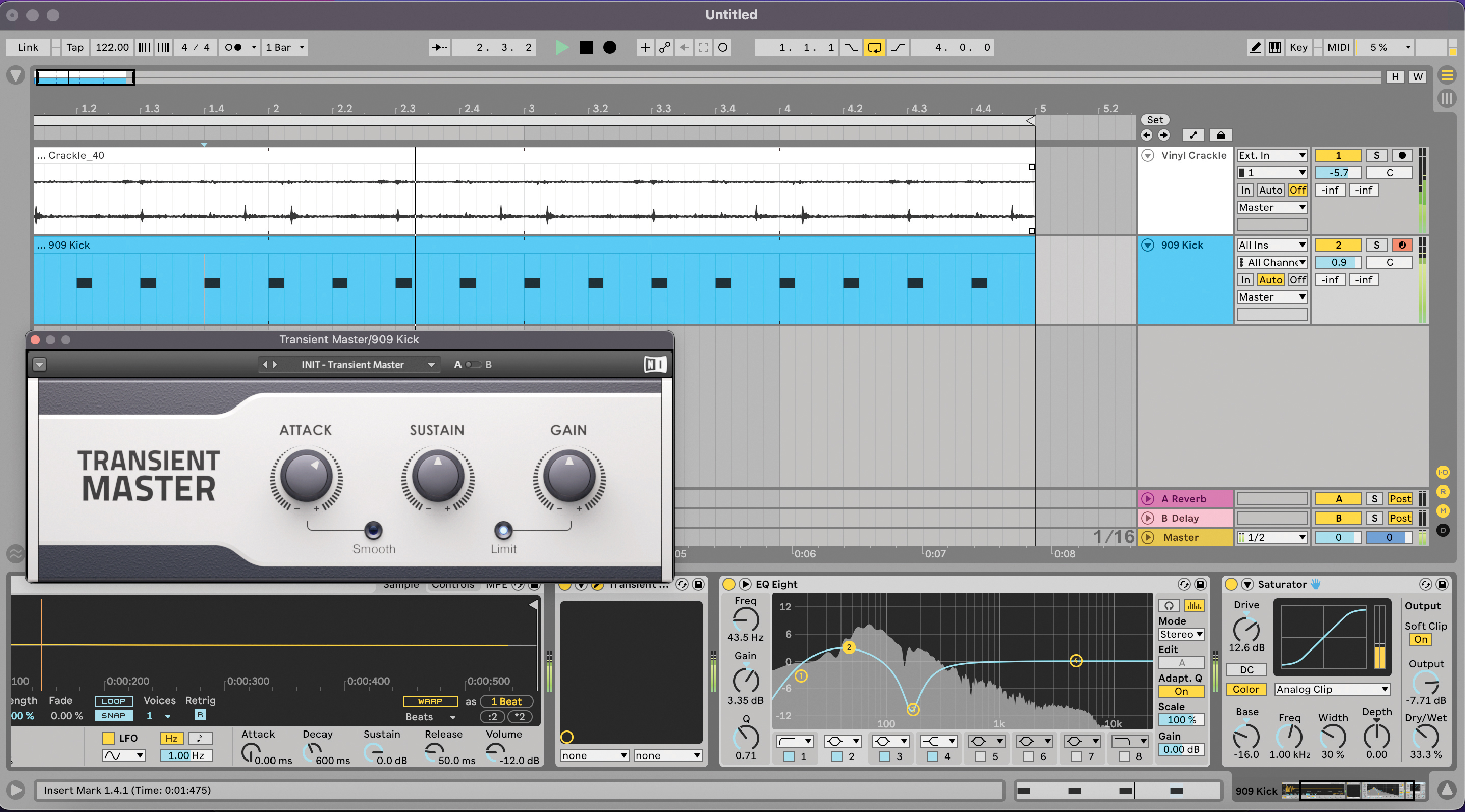
A TR-909 kick drum, layered with a short transient click sample, provides the punchy 4/4 backbone for our retro house rhythm. Processing-wise we apply some front-end snap with a transient shaper, some EQ to remove boxy mids, and tape saturation for grit.
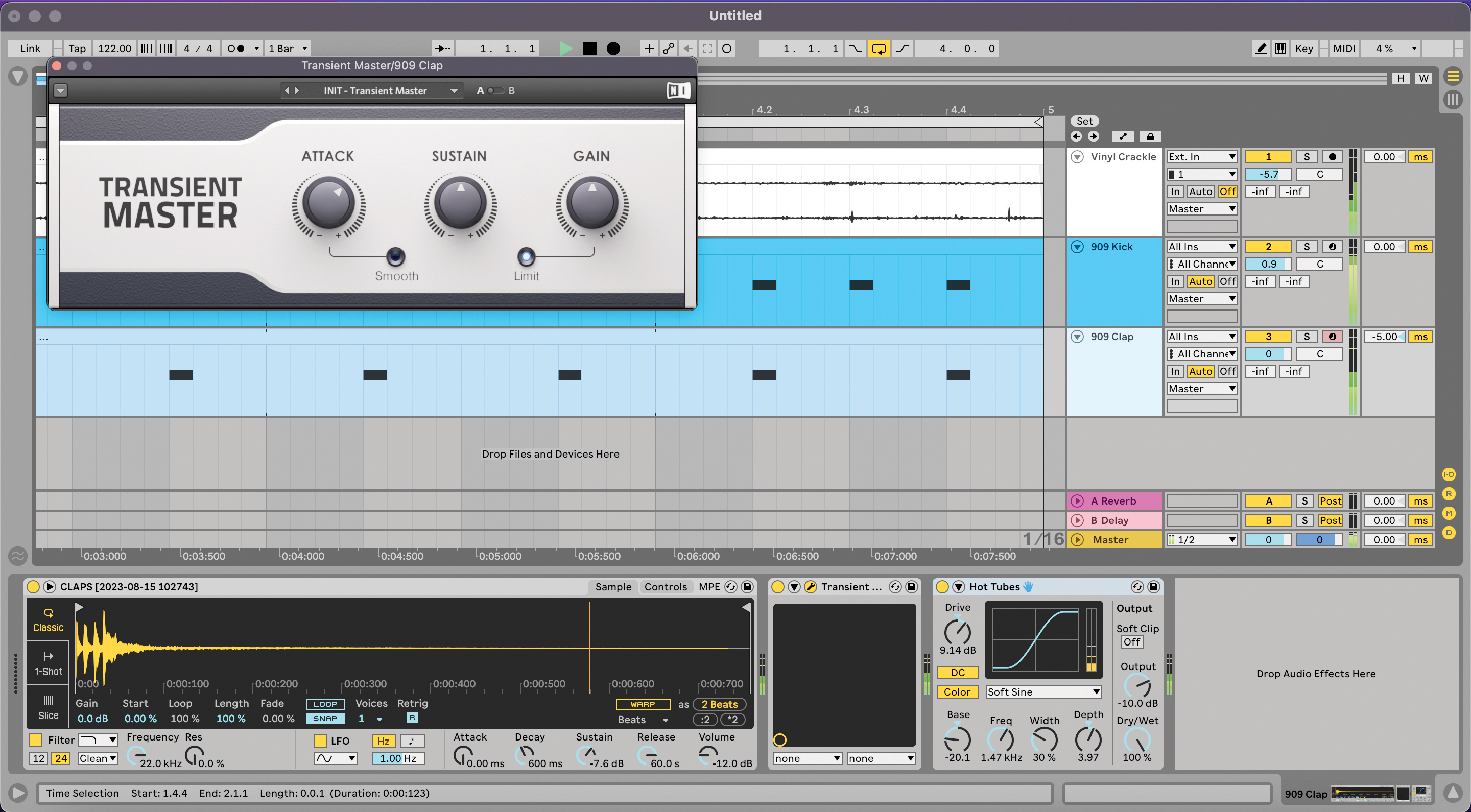
A clap sample, again from the TR-909, is placed on beats 2 and 4 of each bar. Transient shaping and tape saturation add crack and drive, and we also use our DAW’s track delay to pull the clap back by 5ms for more groove.
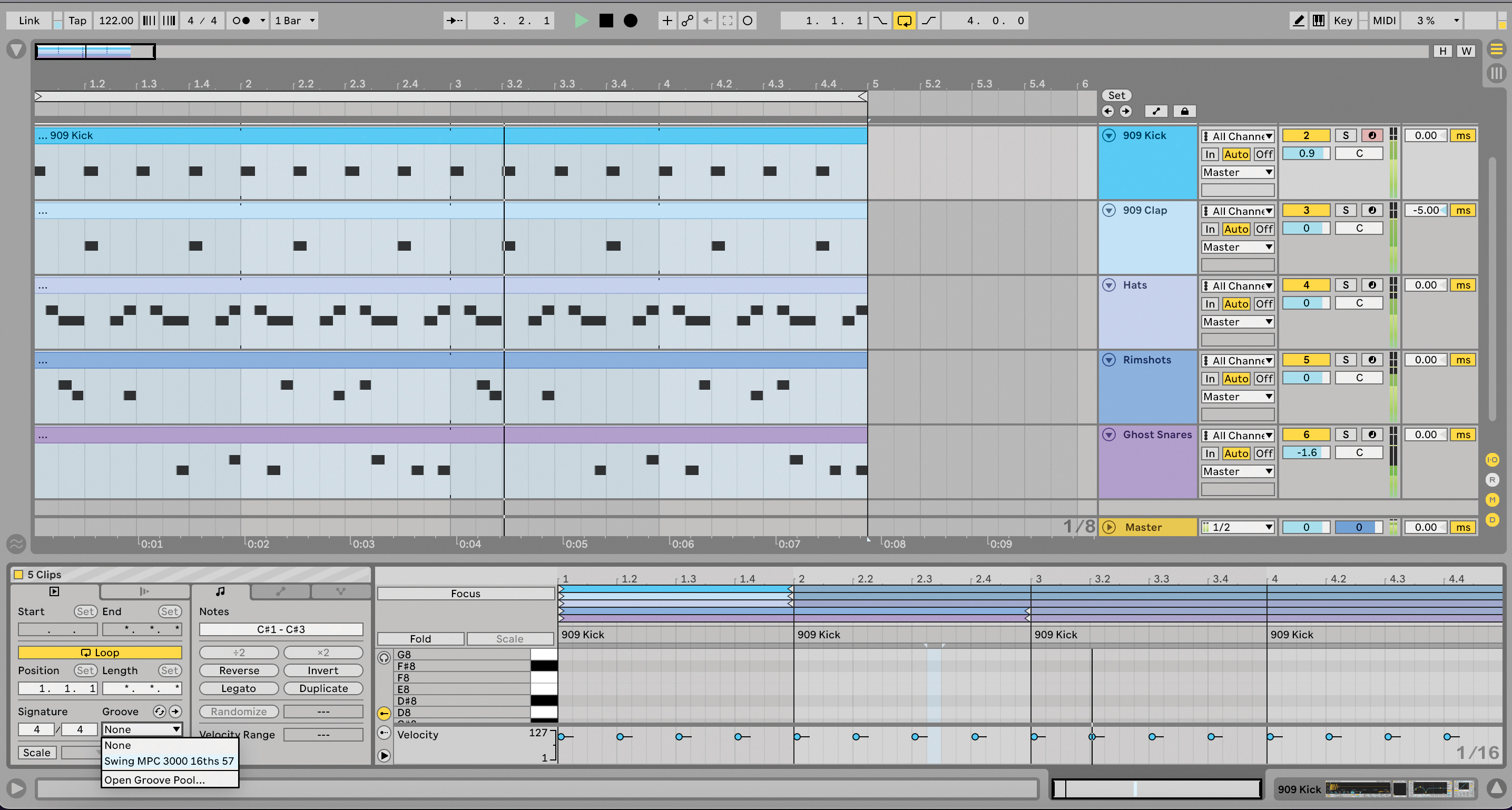
Now we program in the rest of our 909 drums. The open hi-hat sits on the offbeat, while closed hats, rimshots and ghost snares fit around the main hits. The groove of an MPC swing template is applied to the MIDI notes for more of a shuffling garage vibe. You can download the full MIDI file here.
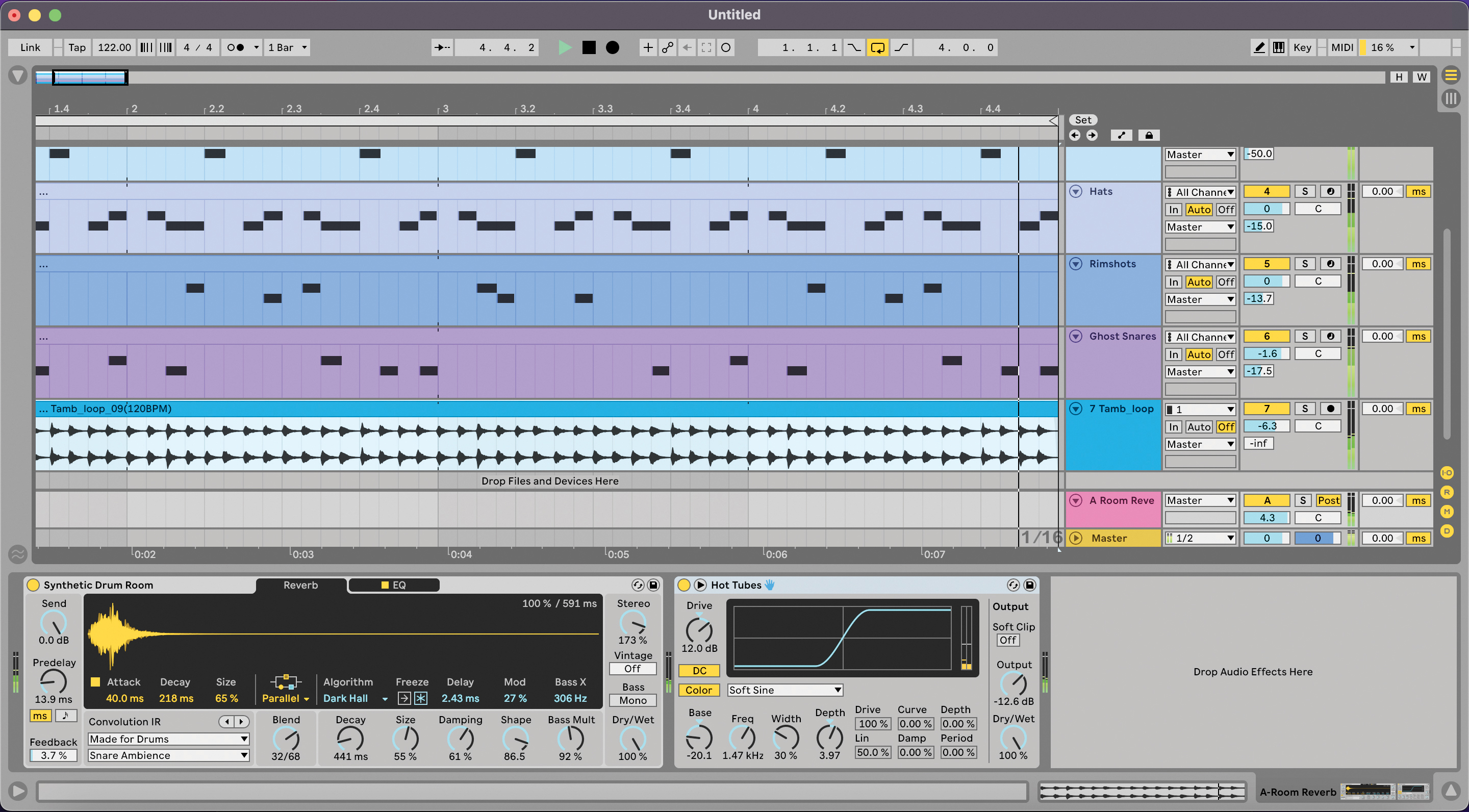
Everything’s sounding extremely dry, so we set up some room reverb on a return channel and send our hi-hats, rims and snares’ signals to this channel. We also add in a shuffling tambourine loop low in the mix to fill in any gaps in the rhythm.
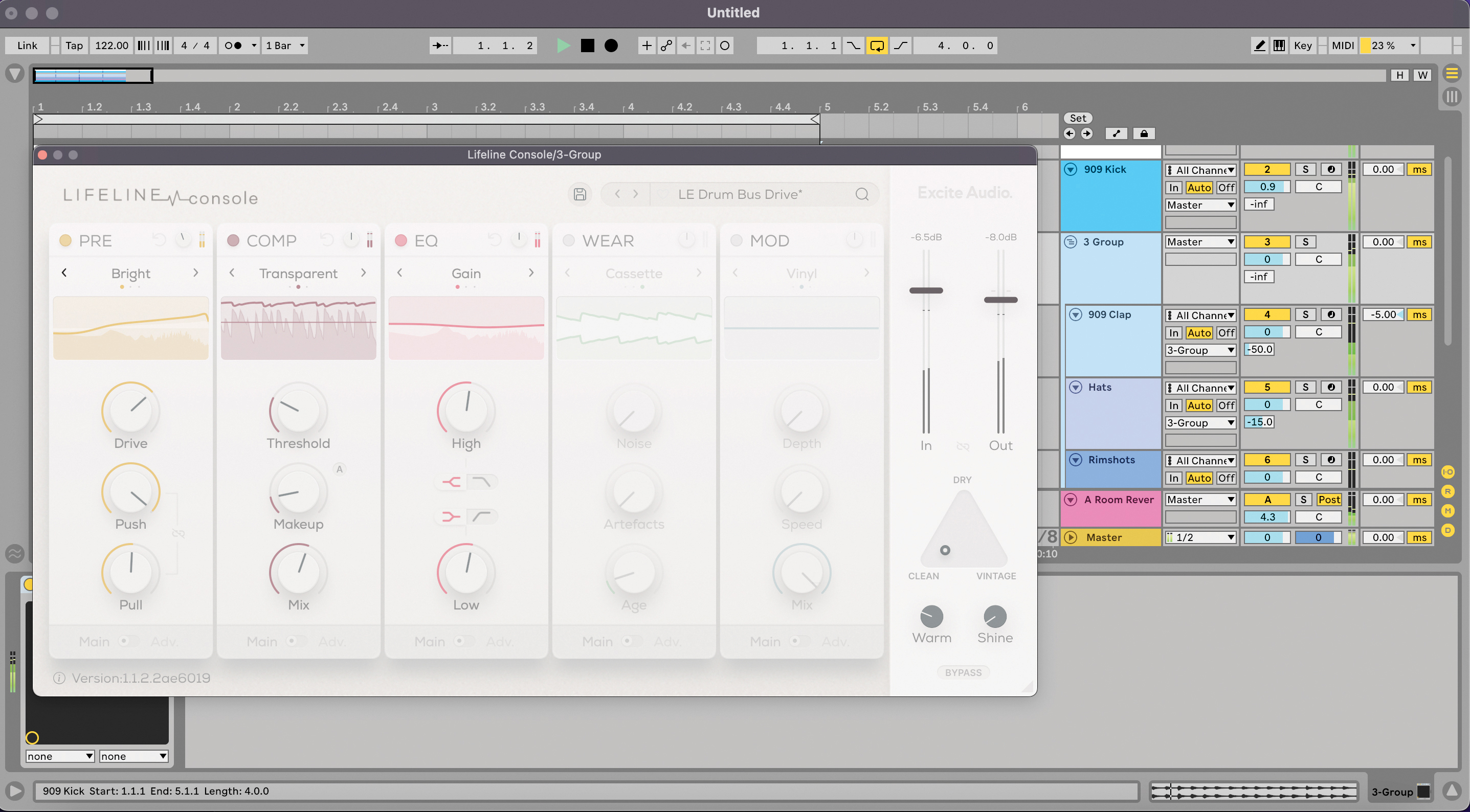
Finally we group all of our drums – except the kick – to a group bus. Here we use some EQ, subtle bus compression and peak limiting to remove treble harshness, giving a unified ‘old-school’ warmth to the beat.







